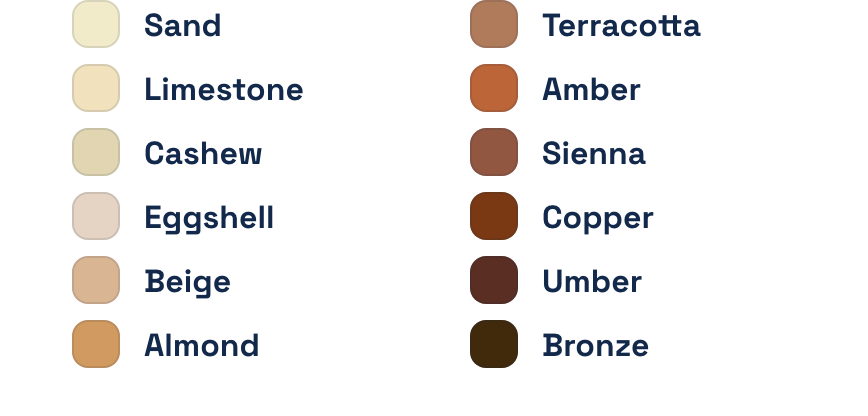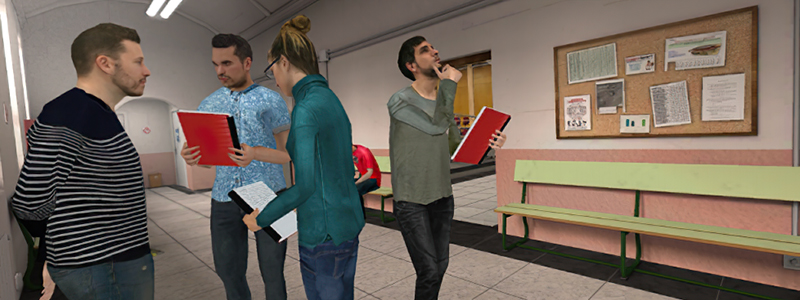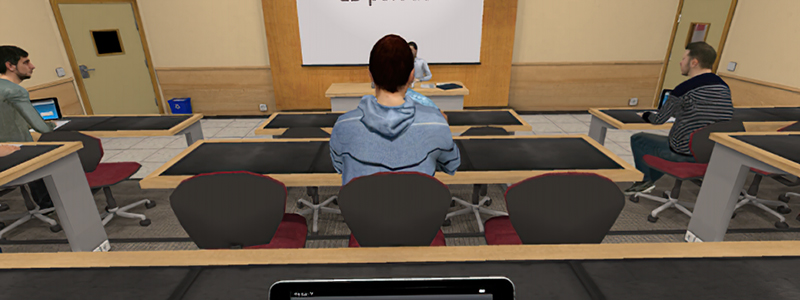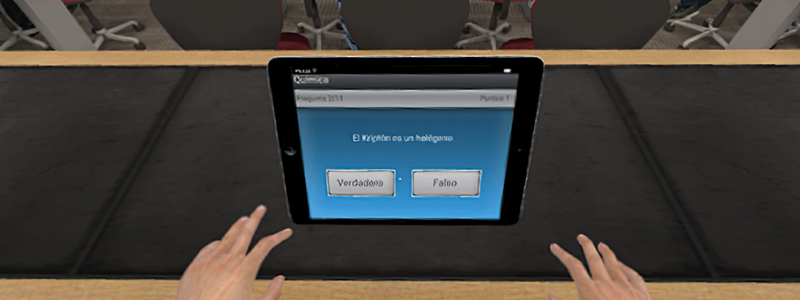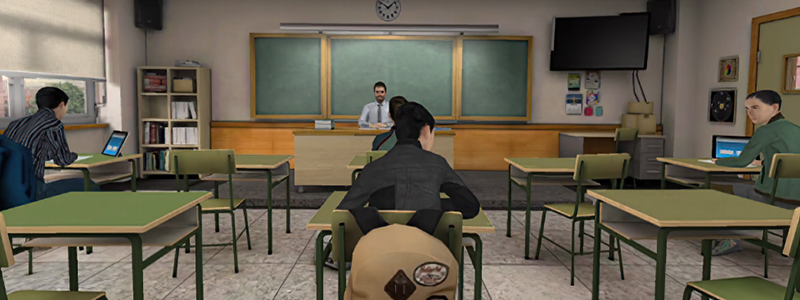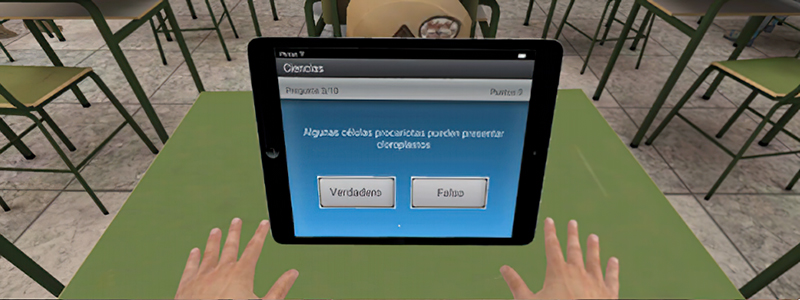Index Agoraphobia Manual
- Agoraphobia and Virtual Reality
- Psious-based Treatment/Evaluation Protocol
- Agoraphobia evaluation
- Goals of evaluation
- Some useful tools for evaluating agoraphobia
- Elaboration of the exhibition hierarchy with Psious environments
- Example of intervention in agoraphobia
- Example of intervention in agoraphobia with 360º videos
- Agoraphobia evaluation
- Use recommendations
- Recommended bibliography
- Annexes
- Diary of Anxiety and Panic Attacks
- Relaxation self-recording
- Underground hierarchy self-recording
- Videos 360º hierarchy self-recording
1. Agoraphobia and Virtual Reality
According to Bados (2006), the problems with panic and agoraphobia are very frequent in clinical practice; specifically, these are the anxiety problems which people consult about most and they constitute around 50-60% of the phobia cases attended in the clinic (Bados, 2009). In general, if data of population of primary health care is analyzed, numbers will show a higher prevalence than in the general population.
Virtual reality (VR) seems to be a good alternative regarding traditional techniques of exposure in the treatment of agoraphobia. Unlike in vivo exposure, virtual reality allows standardization and control over the exposure session parameters. Moreover, this technology is particularly useful for repeating the exposure of the feared situations as many times as necessary (Botella et al, 2004). It also prevents panic attacks, losing the risk of reinforcing the existing fear.
2. Psious-based Treatment/ Evaluation Protocol
All the information in this section is designed to provoke an indicative nature. Psious environments are therapeutic tools that should be used only by healthcare professionals experienced in the evaluation and intervention processes according to the characteristics of their patient’s needs.
There is a General Clinical Guide that contains more information on how to adapt the techniques of psychological intervention (exposure, systematic desensitization, cognitive reorganization, chip economy…) to Psious environments at your disposal if needed.
2.1 Agoraphobia evaluation
2.1.1 Goals of evaluation
- To evaluate the presence and comorbidity of other emotional disorders, especially panic disorder, anxiety disorders and other phobias.
- Evaluate component-related anxiety: being in a public place with many people, feelings of distress and thoughts about not being able to escape.
- Define stimulating configurations feared by the patient and the degree of it. Elaboration Hierarchy of Exposure.
- Evaluate the presence of distorted thoughts: losing control and not being able to escape the situation, suffer a panic attack.
2.1.2 Some useful tools for evaluating agoraphobia
In consideration to the evaluation objectives, we will provide a list of some tools that can be useful to obtain relevant information and characteristics about your patient. Remember that a good definition of objectives, characterization of the patient and planning of the intervention are important for the efficiency and efficacy of the therapy, as well as for satisfaction of your patients. In the bibliography, you will find articles to review the characteristics of the instruments proposed below. A combination of the following tools will be used for a complete evaluation of the problem.
- Open or semi-structured interview.
- Structured interview: Interview for the Anxiety disorders According to DSM-IV (ADIS-IV)
- Observation and self-observation (with auto-registration)
- Diary of anxiety and panic attacks
- Auto-registration of relaxation
- Behavioral approach Test in vivo and/or through virtual reality
- Auto – reports
- Mobility Inventory for agoraphobia: to evaluate the avoidance of situations and places
- Body Sensation Questionnaire: to evaluate the fear of various body sensations
- Questionnaire of agoraphobic cognitions: to evaluate the catastrophic thoughts and physical feelings of anxiety
- Agoraphobia Inventory
- Psious Auto-Reports for the elaboration of the hierarchy
2.1.3 Elaboration of the exhibition hierarchy with Psious environments
Once we have the information from the evaluation, we can proceed to develop the exposure hierarchy. In addition to using the data obtained during the initial assessment, we can make a series of questions (for example: on a scale from 0-100, what level of discomfort would you feel being on a platform waiting for the underground?, a scale from 0 to 100, what level of discomfort would you feel going to shop at a mall with a lot of people?, do you think there is anything that can generate a higher discomfort?…) aimed at planning the intervention through virtual reality.
Here are some items that could be used to create an appropriate hierarchy for treating agoraphobia with Psious. It must be noted that we should ask the patient about the anxiety generated by these situations, and based on this, note and grade the different elements of the hierarchy.
- Driving around the city during low-traffic hours
- Driving around the city during high-traffic hours ( Environment fear to driving, city)
- Highway travel
- Being alone at home (Generalized Anxiety Environment, concern…)
- Going inside an elevator (Claustrophobic environment, Small elevator)
- Being in the Underground entrance (Agoraphobia environment, Metro)
- Being at the platform (Agoraphobia environment, Metro)
- Getting on a plane and closing the doors (Environment fear of flying, Plane)
- Being in the subway wagon with a lot of people (Environment agoraphobia, Metro)
- Being on the street away from home with few people (Environment agoraphobia, Square, Boulevard…)
2.2 Intervention example on agoraphobia
SESSION 1
- Inform the patient about agoraphobia (causes, symptoms, prevalence…)
- Present and justify the techniques that will be used throughout the treatment: the exposure with virtual reality and live exposure.
- Elaboration of the hierarchy of exposure and exposure to items from the hierarchy of 20-30 USA’s (example)
- Start exposure hierarchy with an item close to 30 USA’s. The main objective will be the patient’ s familiarization with the virtual reality and the work dynamics
| Item | USA’s | Environment | Configuration | Event |
| Being in the square next to your house with few people | 20 | Square | ||
| Take a walk on the beach with few people | 20 | Video “The beach” | ||
| Drive around the city during hightraffic hours | 25 | City | Sun, day, driver, minimum | Circuit 1 |
| Drive on the highway | 30 | Highway | Sun, day, driver, show, hide | Tunnel |
SESSION 2
- Review achievements from the previous session and setting objectives of the actual session: entering an elevator
- Starting with the second session of the treatment, we recommend to start the exposure gradually and systematically to environments of virtual reality. If it’s necessary, perform a cognitive restructuring.
- Show clinical advances to the patient, through platform reports.
Exercises to do at home:
Exercises to do at home: Live exposure to streets away from home, or go out for a drive through the city.
| Item | USA’s | Environment | Configuration | Event |
| Being in a square near home with plenty of people | 40 | Square | Maximum | |
| Walking along a very crowded boulevard | 45 | Video Very Crowded Boulevard | ||
| Being alone at home | 50 | Home | ||
| Take a walk along the port | 55 | Video walk | ||
| Entering an elevator | 60 | Small elevator |
SESSION 3
- Review achievements from previous sessions and establish new objectives for this: Being in the underground entrance when there is people there.
- Gradual and systematic exposure to virtual reality environments. Cognitive restructuration, if it’s necessary.
- Show clinical advances to the patient through platform reports.
Exercises to do at home:
Live exposure by going out for a walk in a busy street, being alone at home or entering an elevator (if you have too much anxiety you can do imagery at home, imagining the situations treated in the session).
| Item | USA’s | Environment | Configuration | Event |
| Be in the waiting room of a hospital | 60 | Magnetic resonance imaging | Waiting room | |
| Go into the elevator | 65 | Big elevator | Maximum | Into the elevator |
| Being in the entrance of the Metro without people | 70 | Metro | Non, clean | |
| Being in the entrance of the Metro surrounded by people | 70 | Metro | Maximum, clean |
SESSION 4
- Review the achievements from the previous session and setting new goals: Being on the underground platform
- Gradual and systematic exposure to virtual reality environments. Cognitive restructuration if it’s necessary.
- Show clinical advances to the patient, through platform reports.
Exercises to do at home:
Live exhibition in the underground, you can start at the entrance and walk down stairs to the ticket machines or do the same with imaginary exposure at home.
| Item | USA’s | Environment | Configuration | Event |
| Very crowded boulevard. | 70 | Very crowded boulevard | ||
| Underground entrance | 75 | Metro | Maximum, dirty | |
| Crowded market | 75 | Video crowded market | ||
| Go to the underground platform | 80 | Metro | Maximum, dirty | Platform |
SESSION 5
- Review of previous session achievements and establish the new objective of the session: Enter the underground train
- Gradual and systematic exposure to virtual reality environments. Cognitive restructuration if it’s necessary.
- Repeat each one of the exercises twice.
- Show clinical advances to the patient, through platform reports.
Exercises to do at home:
Live exposure in crowded streets (if reducing anxiety levels is required, the patient can be accompanied), start to enter into the underground (can be done at timetables when there is not many people)
| Item | USA’s | Environment | Configuration | Event |
| Exit from the underground where there is not many people | 80 | Metro | None, dirty | Activate “metro” (if you want to be inside) and then click on “leave metro” ( without being a inside for very long) |
| See how the train arrives without getting in it and waiting for another | 80 | Metro | None, dirty | No event (do not look at the input viewer) |
| Exit a subway where there is plenty of people | 85 | Metro | Maximum, dirty | Activate “metro” (to be inside) and then click on “ leave metro” (without being inside for very long) |
| Enter a plane and close the doors | 90 | Plane | Maximum, sun, day, window, non, off | Taxi |
| Being in the subway near the door | 90 | Agorafobia | Maximum, dirty | “Metro arrival” (and enter with the viewer) |
SESSION 6
- Review of previous session achievements and establish the new objective of the session: Be inside a subway wagon with many people when a breakdown occurs.
- Gradual and systematic exposure to virtual reality environments. Cognitive restructuration if necessary
- Repeat each one of the exercises twice
- Show clinical advances to the patient, through platform reports.
Exercises to do at home:
Live exposure in the subway, you can start with a small amount of people in the station and increase the level of crowdedness. First, the patient stands near the door, gets into the subway and takes it until the next stop. Gradually increase the exposure as the session progresses.
| Item | USA’s | Environment | Configuration | Event |
| See how the train arrives without getting on it | 85 | Metro | Maximum, dirty | “Metro arrival ” and not entering ( let 30 seconds pass) |
| Entering the train with few people | 90 | Metro | None, dirty | “Metro arrival” (and enter with the viewer) |
| Enter the train full of people | 95 | Metro | Maximum, dirty | “Metro arrival” (and enter with the viewer |
| Entering the train and staying inside for a few stops | 100 | Metro | Maximum, dirty | “Inside the metro” and “next station” (several stops) |
| Being on a full train while a breakdown occurs | 100 | Metro | Maximum, dirty | “Inside Metro” and “Breakdown” |
2.2.1 Intervention Example on Agoraphobia with 360º Format Videos
In addition to virtual environments and normal videos, the agoraphobia scene has several 360º format videos that will allow you to make a more effective intervention. The videos described previously can be used to create a storyline for the agoraphobic patient that are similar to situations that he/she could be experiencing in their everyday life. Gradually increasing the level of difficulty of each of these situations will allow the patient to progressively confront and overcome their fears at a much quicker rate. For example, storylines that can be created are prompting a patient to go inside a market (ground floor) and then having them go inside a mall (first and second floor).
To create this storyline, the following videos can be used: The video with the stair landing (leaving the house), the one in the subway (going to the market), the market videos (ground floor) and the one in the mall (elevator, first floor, second floor…) The use of different videos can be used to create a hierarchy of exposure that will help the patient become used to visiting a mall or a market.
SSESION 1
- Inform the patient about agoraphobia (Causes, symptoms, prevalence…)
- Discuss the techniques that will be used throughout the treatment: Exposure with virtual reality and live exposure.
- Prepare the exposure hierarchy and the 20-30 USA’s hierarchy item exposure. (example)
- Initiate exposure hierarchy with an item close to 30 USA’s. The main goal will be to make sure the patient gets comfortable with the virtual reality and the dynamics of the work.
| Item | USA’s | Environment |
| After having left the mall , he/she is out on the street surrounded by people and cars | 20 | 360º video outside the mall |
| On the elevator, going from the last floor to the ground floor to leave the mall. | 25 | 360º video inside the elevator |
| Waiting for the elevator to leave the top floor of the mall. | 30 | 360º video waiting for the elevator. |
| Being at the market’s exit, observing people come in and out. | 40 | 360º video entering a crowded market. |
SESIÓN 2
- Review the achievements from the previous session and establish session goals: Be on the ground floor of a very crowded market, and watch people shop and walk.
- From the second session onwards, it is highly recommended to begin the gradual and systematic exposure to virtual reality environments. Do cognitive restructuring, if necessary.
- Show clinical advances to the patient through platform reports.
Exercises to do at home:
Live exposure, going out into the street and going to a market or a mall. The patient doesn’t have to enter it.
| Ítem | USA’s | Entorno |
| Observe people leaving the subway station, right before entering it to go home. | 40 | 360º Video Subway Exit |
| Being in the entrance hall of their own home after coming back from the mall. | 50 | 360º Video Hall |
| Being out on the street , observing (from a distance) the mall he/she intends to go to. | 55 | 360º Video Outside the Mall |
| Being on the ground floor of a crowded market to observe the massive amount of people shopping and walking around. | 60 | 360º Video Ground Floor |
SESIÓN 3
- Review achievements from the previous session and establish session goals: To be on the first floor of a mall and see the exit doors from a distance.
- Gradual and systematic exposure to virtual reality environments. Use cognitive restructuring, if necessary.
- Show clinical advances to the patient, through platform reports.
Exercises to do at home:
Live exposure, going to market that isn’t as crowded or just standing outside a mall to observe + image exposure to review session goals.
| Ítem | USA’s | Entorno |
| Taking a slightly crowded elevator to go up to the second floor of the mall | 65 | 360º Video inside the elevator |
| Waiting to take an elevator to the first floor at a market surrounded by a few people. | 70 | 360º Video waiting for the elevator |
| On the first floor of a mall with the exit in view in the far distance. | 75 | 360º Video inside the mall. Vídeos |
SESIÓN 4
- Review achievements from the previous session and establish session goals : To be on the first floor of a market to observe people walk around with city buildings in view in the background.
- Gradual and systematic exposure to virtual reality environments . Use cognitive restructuring, if necessary.
- Show clinical advances to the patient through platform reports.
Exercises to do at home:
Live exposure going to a crowded market or to a busy mall.
| Ítem | USA’s | Entorno |
| Watching people (in the hall of the subway exit) coming in and out of the subway before entering a busy market. | 80 | 360º Video Subway Exit |
| At the subway entrance on the way to the market and watching people enter and leave the platform to go out into the street | 80 | 360º Video Subway Exit |
| On the first floor of a mall with escalators in the distance (use them to go up to the last floor). | 90 | 360º Video Inside the Mall Vídeos |
| At the roof terrace (on the top floor of the mall), observing people wandering around with buildings in view in the background. | 100 | 360º Video Second Floor |
3. Recommended Use
It is important to include comments, questions or indicators in the exposure session (to immerse the patient in the situation) so the experience seems more realistic.
Some suggestions for agoraphobia are:
- You are leaving home and you remember you will have to cross a square full of protesters.
- Today we are going to take the underground after work during rush hour. Does it produce anxiety in you? Why?
- You should be leaving for work now since it’s getting late
- If you suffered a panic attack right now, would you be able to manage it?
- You should take the underground because if you walk, you won’t get to your destination on time.
- Right now, you are in the middle of a protest with a lot of people around you. How do you feel?
- Today we will go for a walk from your house to your parents’/friend’s/ girlfriend’s or boyfriend‘s house. This walk will last 10/15/20/”x amount” of minutes.
- Imagine that, upon entering the underground station, your phone runs out of battery.
- On this occasion you find yourself walking through a(n) empty/ moderately busy/extremely busy – street. How do you feel?
- Would you feel any different if you were alone in this situation?
4. Recommended Bibliography
Bados López, A. (2009). Agorafobia y pánico: Naturaleza, evaluación y tratamiento. (http://hdl.handle.net/2445/6261)
Botella, C., García-Palacios, A., Villa, H., Baños, R., Quero, S., Alcañiz, M., & Riva, G. (n.d.). Virtual Reality Exposure In The Treatment Of Panic Disorder And Agoraphobia: A Controlled Study. Clinical Psychology & Psychotherapy, 164-175.
Brown, T. A., DiNardo, P. A., & Barlow, D. H. (1994). Anxiety disorders interview schedule for DSM-IV (ADIS-IV), adult version. Albany (NY): Graywind Publications Inc.
Bullinger, A. (n.d.). Computer generated (virtual reality) three dimensional exposure as a tool in behavioural therapy of agoraphobia. European Psychiatry, 102s-102s.
Cárdenas, G., Muñoz, S., González, M., & Uribarren, G. (n.d.). Virtual Reality Applications to Agoraphobia: A Protocol. CyberPsychology & Behavior, 248-250.
Chambless, D. L., Caputo, C., Bright, P. y Gallagher, R. (1984). Assessment of fear of fear in agoraphobics: The Body Sensations Questionnaire and the Agoraphobic Cognitions Questionnaire. Journal of Consulting and Clinical Psychology, 52, 1090-1097.
Chambless, D. L., Caputo, G. C., Jasin, S. E., Gracely, E. J. y Williams, C. (1985). The Mobility Inventory for Agoraphobia. Behaviour Research and Therapy, 23, 35-44.
Echeburúa, E., de Corral, P., García Bajos, E., Páez, D. y Borda, M. (1992). Un nuevo inventario de agorafobia (IA). Análisis y Modificación de Conducta, 18, 101-123.
J., C. (n.d.). A Randomized Controlled Study of Virtual Reality Exposure Therapy and Cognitive-Behaviour Therapy in Panic Disorder with Agoraphobia. Frontiers in Neuroengineering.
5. Annexes
5.1 Diary of Anxiety and Panic Attacks
| Time and Date | Activity conducted | Sensations | Intensity of the Sensations (0-10) | Alone or in company | ||
| Before | During | After | ||||
5.2 Relaxation: Self-Recording
| Date | Time | Level of relaxation before (0-100) | Level of relaxation after (0-100) | Time | Comments |
5.3 Underground Hierarchy: Self Recording
| Item | Discomfort Level (0-100) |
| I’m walking in a square heading towards the subway, which is close to home. | |
| I walk through the corridors of the station to head towards the platform and I realize the station is pretty clean. There is no one around me. When I reach the platform, I stop near the entrance. | |
| I’m inside a train with a few people. When I get to my stop, I get off the train and leave the platform. | |
| I’m standing on the platform with no one around me. The subway arrives, but I do not get in. I wait for the next one instead. | |
| When entering the station, I see there is nobody inside and that the station seems to be quite clean | |
| I am standing on the subway platform (which is quite dirty) with no one next to me. I enter the train when it arrives, but I stay close to the wagon door. | |
| I’m in the middle of a subway wagon surrounded by a few people. I still have 3 stops left on my itinerary so when we reach the next stop, I do not get off. I decide to continue forward with my journey for the remainder of the stops. | |
| I’m in an empty square and I’m about to cross it to enter the subway station | |
| I’m inside a subway wagon with plenty of people. When we get to the next stop, I get off to leave the train | |
| I’m inside a subway wagon with a few people. When it reaches the next stop, I do not get off since I still have 5 stops left on my itinerary | |
| I’m walking through the halls of the station heading towards the platform . There is one around me, and I notice that the station is quite dirty. When I get to the platform, I stop near the entrance. | |
| I’m in a subway with few people around me when the train comes to an unexpected stop. A breakdown has occurred. | |
| I’m in the middle of a crowded subway wagon. When it reaches the next stop, I do not get off, as I still have 2 stops left. I continue forward to my destination. | |
| I’m standing on a platform with people around me. The subway arrives, but I do not get on. I watch it depart from the platform. | |
| I’m standing on the platform (which is quite dirty) with no one around me. The subway arrives and I sit down. | |
| When I enter the lobby of the subway station, I notice that nobody is there. The atmosphere looks dirty and dark. | |
| I’m standing on the platform (which is quite dirty) with no one around me. The subway arrives and I sit down. | |
| When I enter the lobby of the subway station, I notice that nobody is there. The atmosphere looks dirty and dark. | |
| I’m in the middle of a subway wagon with a lot of people. When it reaches the next stop, I do not get off. I still have 7 stops left on my itinerary so I continue on to my destination. | |
| I walk through the corridors of the station and start heading to the platform. I see plenty of people around and the station is a bit dirty and looks dark. When I get to the platform, I stop to wait for the train. | |
| When I enter the station lobby, I notice it is full of people and that the station seems to be quite clean. | |
| I am standing on the subway platform (which is quite clean) with no one around me. When the train arrives, I enter. | |
| I’m in a subway wagon with many people on it. When it reaches the next stop, I do not get off. I have 5 stops left, so I continue on until I reach my destination. | |
| I’m standing on the subway platform (which is quite clean) with a few people around me. When the train arrives, I get in. | |
| I’m inside the subway wagon with a lot of other people. When we reach the next stop, I do not get off.I have 7 stops left, so I continue on until I reach my destination. | |
| I’m walking through the halls of the station heading towards the platform . There is no one around me and the station looks quite clean. When I get to the platform, I stop to wait for the train. | |
| When I enter the lobby of the station, I see that it is full of people. I also notice that the station is dirty and dark. | |
| I’m standing on the subway platform (which is quite clean) with people around me. When the subway arrives, I sit down instead of getting on it. | |
| I’m standing on the platform (which is quite dirty) with a few people around me . When the subway arrives and I enter it. | |
| I’m standing on the platform (which is quite clean) with no one around me. When the subway arrives, I sit down instead of getting on it. | |
| I’m in a subway wagon with a lot of people around me. The train suddenly stops. It seems there has been a breakdown. |
5.4 360º Hierarchy Videos: Self-Recording
| Item | Discomfort Level (0-100) |
| Now I’m outside of the market. I can see people going in and coming out. | |
| I’m in the hall of my apartment and I’m about to start my journey to the mall. | |
| I’m inside an elevator going from the top floor to the ground floor because I’m leaving the mall. | |
| I’m at the entrance of thee subway because I am on my way to the mail, I see people exiting the platform and going out to the street | |
| I’m at the entrance of the subway because I am on my way to the mall. I see people exiting the platform and going out to the street. | |
| I enter the mall elevator. I am standing next to four people. I am going up to the second floor | |
| I’m standing in a very busy mall. I can see plenty of people walking and shopping around me. | |
| After leaving the mall, I stop outside for a moment to observe people walking around and cars driving in the area. | |
| I’m inside the mall on the first floor. I am far from the exits, but I can see them in the distance. | |
| I’m in a mall waiting for the elevator to go up to the first floor. There are a few people next to me. | |
| As I’m approaching the subway station to head home, I can see people exiting the station | |
| I’m in the corridor of the subway station exit watching people coming and going. I am on my way to the mall and I know it will be very crowded | |
| I’m on the first floor of the mall and I can see the escalators that I need to take to the top floor in the distance. | |
| I’m on the top floor of the mall waiting for the elevator. I need to take it to the ground floor in order to get to the exit. |
